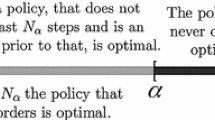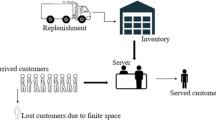Abstract
This paper investigates the effect of permissible delay in payments on ordering policies in a periodic review (s, S) inventory model with stochastic demand. A new mathematical model is developed, which is an extension to that of Veinott and Wagner (Mngt Sci 1965; 11: 525) who applied renewal theory and stationary probabilistic analysis to determine the equivalent average cost per review period. The performance of the model is validated using a custom-built simulation programme. In addition, two distribution-free heuristic methods of reasonable accuracy develop approximate optimal policies for practical purposes based only on the mean and the standard deviation of the demand. Numerical examples are presented with results discussed.


Similar content being viewed by others
References
Haley CW and Higgins RC (1973). Inventory policy and trade credit financing. Mngt Sci 20: 464–471.
Goyal SK (1985). Economic order quantity under conditions of permissible delay in payments. J Opl Res Soc 36: 335–338.
Chand S and Ward J (1987). A note on economic order quantity under conditions of permissible delay in payments. J Opl Res Soc 38: 83–84.
Chung KJ (1997). A theorem on the determination of economic order quantity under conditions of permissible delay in payments. Comput Oper Res 25: 49–52.
Kim J, Hwang H and Shinn S (1995). An optimal credit policy to increase supplier's profit with price dependent demand functions. Prod Plann Control 6: 45–50.
Shinn SW (1997). Determining optimal retail price and lot size under day-terms supplier credit. Comput Ind Engng 33: 717–720.
Hwang H and Shinn SW (1997). Retailers pricing and lot sizing policy for exponentially deteriorating products under the conditions of permissible delay in payments. Comput Oper Res 24: 539–547.
Shinn SW, Hwang H and Park SS (1996). Joint price and lot size determination under conditions of permissible delay in payments and quantity discounts for freight cost. Eur J Opl Res 91: 528–542.
Shah VR and Sreehari M (1996). An inventory model for a system with multiple storage facilities and conditional credit facility. Opsearch 33: 96–106.
Aggarwal SP and Jaggi CK (1995). Ordering policies of deteriorating items under permissible delay in payments. J Opl Res Soc 46: 658–662.
Chu P, Chung KJ and Lan SP (1998). Economic order quantity of deteriorating items under permissible delay in payments. Comput Oper Res 25: 817–824.
Jamal AMM, Sarker BR and Wang S (1997). An ordering policy for deteriorating items with allowable shortage and permissible delay in payment. J Opl Res Soc 48: 826–833.
Jamal AMM, Sarker BR and Wang S (2000). Optimal payment time for a retailer under permissible delay of payment by the wholesaler. Int J Prod Econ 66: 59–66.
Sarker R, Jamal AMM and Wang S (2000). Supply chain models for perishable products under inflation and permissible delay in payment. Comput Oper Res 27: 59–75.
Liao HC, Tsai CH and Su CT (2000). An inventory model with deteriorating items under inflation when a delay in payment is permissible. Int J Prod Econ 63: 207–214.
Teng J-T (2002). On the economic order quantity under conditions of permissible delay in payments. J Opl Res Soc 53: 915–918.
Kingsman BG (1983). The effect of payment rules on ordering and stockholding in purchasing. J Opl Res So 34: 1085–1098.
Chapman CB, Ward SC, Cooper DF and Page MJ (1984). Credit policy and inventory control. J Opl Res Soc 35: 1055–1065.
Khouja M and Mehrez A (1996). Optimal inventory policy under different supplier credit policies. J Manuf Systems 15: 334–339.
Chung KH (1989). Inventory control and trade credit revisited. J Opl Res Soc 40: 495–498.
Rachamadugu R (1989). Effect of delayed payments (trade credit) on order quantities. J Opl Res Soc 40: 805–813.
Aggarwal SP and Jaggi CK (1994). Credit financing in economic ordering policies of deteriorating items. Int J Prod Econ 34: 151–155.
Davis RA and Gaither N (1985). Optimal ordering policies under conditions of extended payment privileges. Mngt Sci 31: 499–509.
Arcelus FJ and Srinivasan G (1993). Delay of payments for extraordinary purchases. J Opl Res Soc 44: 785–795.
Silver E, Pyke D and Peterson R (1998). Inventory Management and Production Planning and Scheduling, 3rd edn. John Wiley and Sons: New York.
Veinott Jr AF and Wagner H (1965). Computing optimal (s, S) inventory policies. Mngt Sci 11: 525–552.
Şahin I (1989). Regenerative Inventory Systems: Operating Characteristics and Optimization. Bilkent University Lecture Series, Springer-Verlag: New York.
Arrow KJ, Harris T and Marschak J (1951). Optimal inventory policy. Econometrica 19: 250–272.
Iglehart D (1963). Optimality of (s, S) policies in the infinite horizon dynamic inventory problem. Mngt Sci 9: 259–267.
Federgruen A and Zipkin P (1984). An efficient algorithm for computing optimal (s, S) policies. Opns Res 32: 1268–1285.
Zheng YH and Federgruen A (1991). Finding optimal (s, S) policies is as simple as evaluating a single policy. Opns Res 39: 654–665.
Wagner H (1975). Principles of Operational Research, 2nd edn. Prentice-Hall: Englewood Cliffs, NJ.
Ehrhardt R (1979). The power approximation for computing (s, S) inventory policies. Mngt Sci 25: 777–785.
Ehrhardt R and Mosier C (1984). A revision of the power approximation for computing (s, S) inventory policies. Mngt Sci 30: 618–622.
Law AM and Ketlon WD (1991). Simulation Modeling and Analysis, 2nd edn. McGraw-Hill: New York.
Fu MC and Kevin JH (1997). Techniques for optimization via simulation: an experimental study on an (s, S) inventory system. IIE Trans 29: 191–199.
Johansen SG (1999). Lot sizing for varying degrees of demand uncertainty. Int J Prod Econ 59: 405–414.
Schneider H and Ringuest J (1990). Power approximations for computing (s, S) policies using service level. Mngt Sci 36: 822–834.
Banerjee A (1986). A joint economic-lot size model for purchaser and vendor. Decision Sci 17: 292–311.
Acknowledgements
We are grateful to the two referees for their constructive comments and suggestions. BS Maddah thanks his current academic advisor, Dr Ebru Bish of Virginia Tech, for her support and encouragement while this work was being revised.
Author information
Authors and Affiliations
Corresponding author
Appendices
Appendix B: The SPAM of Schneider and Ringuest38
Evaluate λ τ , σ τ , and D p as in Appendix A.
Find

where

The value of q above is determined according to the values of c using a rational approximation as follows:
If c<0.5, set w=(ln (1/c 2))0.5. Otherwise, set w=c, and then compute q by

where if c<0.5, then

If c⩾0.5, then

Find

where

The value of g above is found based on w=(ln (25/v 2))0.5 where v=(1−γ)μ/σ τ .

where

Finally, the ‘optimal’ policy is obtained as follows:
if D p /λ>1.5, then the ‘optimal’ policy is ŝ=s p and Ŝ=s p +D p .
Otherwise, the optimal policy is ŝ=min(s p , S 0) and Ŝ=min(s p +D p , S 0 ).
Appendix A: The RPAM of Ehrhardt and Mosier34
Let λ and σ be the mean and standard deviation of the demand per review period. Find the following


and

If D p /λ>1.5, then the ‘optimal’ policy is ŝ=s p and Ŝ=s p +D p .
Otherwise, the optimal policy is ŝ=min (s p , S 0) and Ŝ=min (s+D p , S 0), where

with Φ−1(·) being the inverse cumulative density function of the standard Normal distribution. The values of Φ−1(·) function are usually tabulated. Silver et al 25 (pp 735–736) provide an accurate rational approximation for this function, which is suited for spreadsheets applications.
Rights and permissions
About this article
Cite this article
Maddah, B., Jaber, M. & Abboud, N. Periodic review (s, S) inventory model with permissible delay in payments. J Oper Res Soc 55, 147–159 (2004). https://doi.org/10.1057/palgrave.jors.2601675
Received:
Accepted:
Published:
Issue Date:
DOI: https://doi.org/10.1057/palgrave.jors.2601675




